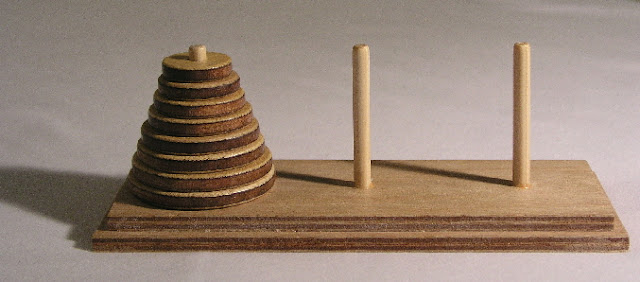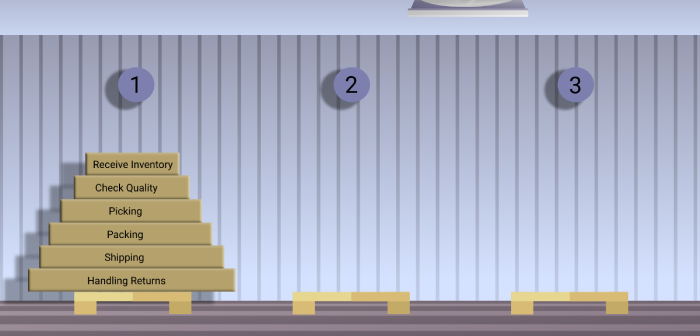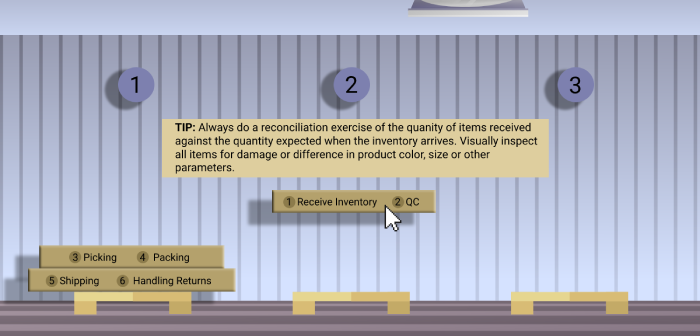One of the easiest puzzle games to build digitally is the Tower of Hanoi. It is a game which involves Ordering and Arrangement of disks on a tower (a stick or a rod). In e-learning content, you will find situations which involve ordering of items. Items may be arranged based on Size, Quantity, Position, Time, etc.. A topic about the size of planets in the solar system involves visualizing the planets from big to small (or vice-versa). Similarly, an e-learning module on climate change or quantity of carbon emissions involves visualizing the data from more to less. Likewise, a Standard Operating Procedure will require visualizing the order of Steps in the SOP.
The Tower of Hanoi puzzle
The Tower of Hanoi is also known by other names like Tower of Brahma, Lucas' Tower and the Pyramid puzzle. The game has disks of different diameters that can slide into three vertical rods called Towers. The game starts with all the disks stacked on one tower in the order of size, such that the smallest disk is on the top and the largest disk is at the bottom giving the arrangement the shape of a cone. The objective of the game is to move all the disks from the first tower to the third tower. The player can use the second tower to stack the disk temporarily. The game has 2 simple rules:
- The player can move only one disk at a time
- A disk of a larger diameter cannot be placed on a disk of a smaller diameter
You may recognize the game from this image below.
Ordering game in e-learning
Tower of Hanoi can be used in e-learning when the discussion is about things that have a defined order or arrangement such as ascending or descending. However, since this is a type of game where the end arrangement is shown upfront, we may not be able to use it as a quiz. In other words, we will not be able to score the learner for knowing the correct order or arrangement. However, you could score the player in one of the following ways:
- Time taken to complete the puzzle
- Number of moves made to complete the game
When implementing the game in an e-learning module, we will need to modify the basic design of the game by adding contextual elements to make it more engaging. Contextual elements can be backgrounds, graphic elements, icons, text or even audio that will help the learner connect with the discussion easily.
Game-based learning example
If we consider a module that is aimed at training delivery agents to fulfill an online order, we may for instance have a topic around Standard Operating Procedure (SOP) for Order fulfillment which discusses the stages of the Order Fulfillment cycle:
- Receiving the inventory
- Quality check
- Picking from shelf
- Packing the item
- Shipping
- Handling returns
Game elements
Let's customize the Tower of Hanoi game for our e-learning topic. The above stages have an order. The first stage is Receiving the inventory and the last is Handling returns. So, each of our disks would be a stage name, with Receiving the inventory on the top and Handling returns at the bottom. The learner, in our case the delivery agent, would be very familiar with a warehouse as this is a place he would quite frequently visit during the course of his work. Therefore, our contextual elements including the environment must be associated with a warehouse. To achieve this, we will use the following:
- Ambience / Background: Warehouse interior
- Towers / Rods: Wooden Pallet (Storage racks or forklifts will also work)
- Disks: Packages (for delivery)
Game instructions
There are 6 boxes on the first wooden pallet to the left. The box labels have 6 Stages of an order fulfillment process. They are arranged from top to bottom in the correct sequence. As a warehouse staff, you are required to move the packages to the third wooden pallet by moving one box at a time. You can only move the box on the top of a stack. You cannot place a bigger box over a smaller box. You can use the middle pallet to temporarily keep the boxes if you like.
Other contextual items that can be added to the game:
- Ambient sounds of a warehouse
- Adding accurate markings on boxes
- Using the company logo
- The numbers 1, 2 and 3 can be signage, location numbers or rack numbers. Example: G Aisle, Pallet Storage Area, R7, etc.
- Distractors, such as a forklift operator driving a forklift loaded with boxes past the screen, making a humourous remark.
Game complexity
The minimum number of steps required to complete the Tower of Hanoi game is 2n - 1, where n is the number of disks. Based on this equation, the below list shows the number of disks and the corresponding minimum number of steps required to complete it.
| Number of disks | Minimum number of steps |
| 3 | 7 |
| 4 | 15 |
| 5 | 31 |
| 6 | 63 |
| 7 | 127 |
As you can see, arranging 6 disks will take 63 steps. Some learners may not have the patience to complete it. Unless we are sure that the majority of our learners will have the perseverance to complete it, we should limit the number of disks to 5. In cases where the number of disks are greater than 5, we could group adjacent items into a single disk. In the image below, we have grouped stages 1 and 2 into a single disk, stage 3 and 4 into one and stages 5 and 6 into one.
This reduces the total disk count to 3 which can be completed in a minimum of 7 steps.
Reinforcement text or tips on Drag/Drop or Roll-over
The game can be used to reinforce learning by bringing up definitions or tips for the learner when they drop a disk.
The tip can stay for a certain duration and then hide. The tips must be relevant to the item that was dragged. This could be one tip from a collection of five that come up randomly. Optionally, it could always be one tip per disk.
Closing remarks…
By creating a good story and contextual elements it is possible to turn a simple game into an engaging one. There are several games such as this that are under-utilized in e-learning. We will look at more such games and interactives in the upcoming posts.
Credits:
Image by macrovector on Freepik, Image by studio4rt on Freepik




